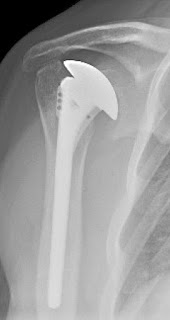An active man in his late 20s had a right shoulder labral repair. After a dirt bike accident two years later he had glenohumeral instability and the x-ray appearance shown below.
He was treated with a revision posterior labral repair with an anteroinferior capsular shift and glenohumeral debridement.
Three years later he presented with a history of a chronically painful stiff shoulder requiring narcotic medication and this x-ray appearance.
The explanation for this arthritic change was unclear.A swab of the unprepared shoulder skin in clinic grew 3+ Cutibacterium.
Because of his physical job and young age, he elected a ream and run procedure. At the time of the procedure it was noted that he was receiving supplemental testosterone which is thought to increase the risk of a Cutibacterium periprosthetic infection. At the time of this procedure another skin swab of the unprepared shoulder skin grew 2+ Cutibaterium. A swab of the freshly incised dermal edge grew 2+ Cutibacterium as well. His surgery went well and included soft tissue releases, glenoid reaming, Betadine lavage, topical vancomycin, and a 3 week course of postoperative oral antibiotics.
His postoperative x-ray is shown below.
After a "honeymoon" period of progressively improving comfort and function his shoulder became stiff and painful. Four months after his arthroplasty a manipulation under anesthesia was performed with a temporary gain in motion. Because of the return of painful stiffness he had a joint aspiration under fluoroscopic control. Minimal fluid was obtained and the culture of this fluid showed no growth. The radiographic appearance at that time showed an irregular glenoid surface with medial erosion.
One month later, because of persistent pain and stiffness requiring narcotic medication, he desired to proceed with a single stage prosthesis exchange with glenoid debridement and postoperative intravenous antibiotics.
At the time of the revision a preoperative skin swab of his unprepared skin surface grew 1+ Cutibacterium.
A frozen section showed "synovium with fibrosis, reactive hyperplasia, mononuclear inflammation and deposition of metallic particles, consistent with prosthetic joint wear debris. No significant neutrophilic inflammation."
His intraoperative cultures for Cutibacterium were as below. They are notable because the bacteria were not evenly distributed in the wound and that the explants yielded the higher levels of Cutibacterium than the soft tissues.
Soft tissue
Collar membrane - no growth
Humeral membrane - broth only
Glenoid membrane - 1+
Suture anchor - no growth
Explants
Humeral head 1+
Humeral stem 1+
After 6 weeks of intravenous antibiotics he remains on oral antibiotics.
At three months after revision, he is off narcotics and is back to light duty. He has active elevation to 150 degrees with some residual shoulder pain. His x-ray at 3 months after surgery is shown below.
We have come to recognize the "honeymoon" as a characteristic of Cutibacterium periprosthetic infection.
The negative fluid aspirate and lack of acute inflammation on the frozen section are common with Cutibacterium periprosthetic infections.
The high levels of Cutibacterium on the explants at the time of revision to the value of culturing prosthesis that are removed at revision.
Finally, the questions of whether the treatment of the periprosthetic infection has failed can only be answered if a subsequent re-revision reveals positive deep cultures for Cutibacterium.
Here are some videos that are of shoulder interest
Shoulder arthritis - what you need to know (see this link).
How to x-ray the shoulder (see this link).
The total shoulder arthroplasty (see this link).
The ream and run technique is shown in this link.
The cuff tear arthropathy arthroplasty (see this link).
The reverse total shoulder arthroplasty (see this link).
The smooth and move procedure for irreparable rotator cuff tears (see this link).
Shoulder rehabilitation exercises (see this link).
Follow on twitter: Frederick Matsen (@shoulderarth)





